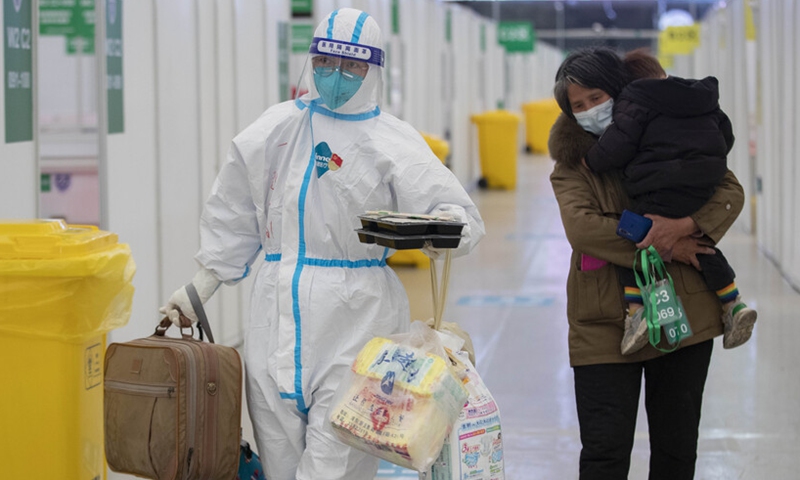Two Shanghai districts eliminate community infections
Current wave may ebb away at end of May with total tally reaching 600,000: experts

Photo: Shanghai Observer
Shanghai is seeing a glimmer of hope after battling the Omicron variant for almost a month and a half, with two districts announcing they have stamped out infections within communities, and the number found outside quarantine areas has fallen for consecutive days.
According to modeling based on the current tally, experts said that the wave in Shanghai may ebb away at the end of May with the total infection tally topping out at 600,000.
Two districts in Shanghai, Jinshan and Chongming, were the first that managed to eliminate viral spreading within communities, a Shanghai government official said during a Wednesday briefing.
Chinese Vice Premier Sun Chunlan said that the COVID-19 battle in Shanghai has achieved a "phased victory" and pointed out that speeding up the elimination of viral spread within communities is an important measure that prioritizes people's lives, media reported on Wednesday.
Sun also said it was important to make sure the virus won't rebound in the districts that stamped out infections outside of quarantined areas.
Although the daily tally in Shanghai has remained at the five-digit level, new cases - both confirmed and asymptomatic - found outside closed-loop quarantine areas fell 54 percent within the past five days, from 852 on April 15 to 390 on Tuesday.
The fact that cases keep tapering off within communities, and that most new cases are being found in quarantine facilities, is proof that Shanghai's strict anti-virus measures are working, and it's a positive sign, Chen Xi, an associate professor of public health at Yale University, told the Global Times.
He noted that the multiple rounds of nucleic acid tests Shanghai is rolling out are also helping to find potential virus carriers. "If the number of cases found within communities continues to decline, the new daily tally will taper off within a few days."
Wu Qianyu, an official from the Shanghai health authority, said that based on previous tests, more than 4 million people were released from sealed-off districts, where the strict curbs on movement have been enforced.
"The city's epidemic situation in recent days has shown a downward trend, the number of streets and towns reporting more than 100 daily cases has fallen consecutively for three days, and community spread has been effectively curbed," Wu said.
The number of patients discharged from quarantine centers has also been climbing, with 27,093 people released from those centers on Tuesday, 3,807 more than on Monday.
Shanghai reported 16,407 new local asymptomatic cases for Tuesday, down from 17,332 on the previous day. Symptomatic cases stood at 2,494, down from 3,084.
Yao Maosheng, a professor at the College of Environmental Sciences and Engineering at Peking University, who has closely followed the COVID-19 pandemic, made a model based on Shanghai's daily tally.
He told the Global Times that the total number of infections in Shanghai is expected to reach 580,000 to 600,000 in the current wave of Omicron. By the end of April, the daily number could fall below 6,000, and Shanghai will be in a much better position to handle the potential remaining infections, said Yao.
A Shanghai resident Catherine You (pseudonym) told the Global Times that her community, which is home to about 1,000 people, is still under the most stringent measures and people cannot leave their houses. She said they did four nucleic tests during the past four days, and it was done one building after another, and each person was asked to keep 2 meters away from others, in order to avoid gathering.
You also observed that the food supply issue, which has sparked wide criticism among Shanghai residents, has improved this week. "It's not like what we had during the pre-outbreak era, but it's better …I bought fruit and flour via group-buying, to get my child more vitamins."
The local government has been ratcheting up efforts to satisfy local residents, including an increase in food supply and a guaranteed smooth delivery chain.
Tao Ailian, an official from Shanghai's market supervision bureau, said during Wednesday's conference that the department will strictly investigate and punish cases of providing problematic food, after recent complaints from residents that they received substandard pork products as supplies during the community lockdown.
Despite the positive trend, worrying signs also emerged as the city reported seven more deaths of COVID-19 patients for Tuesday, two of whom were under 60 years old. These deaths took the toll in Shanghai to 17. Coronavirus wasn't direct cause of all of those deaths, with many suffering underlying conditions, local officials said.
The Shanghai government said on Wednesday that nearly 20 percent of the infected are aged above 60. Yet the city's vaccination rate for this vulnerable group stood at a relatively low level, with only 62 percent of the city's 3.6 million elderly - aged 60 and above - fully vaccinated.
Chen predicted that deaths may keep climbing, given the city's large-scale infection and the size of its unvaccinated vulnerable group.
For Shanghai's next stage in the battle against COVID-19, it should continue to optimize its medical resources, which are being greatly strained by the ballooning number of cases.
The government should also communicate with the public, to prepare people for a scenario with more deaths and assuage their anxiety during the prolonged quarantine.





